How to Identify 5 Common Summer Lawn Diseases in the UK (Red Thread, Fusarium, Rust & More)
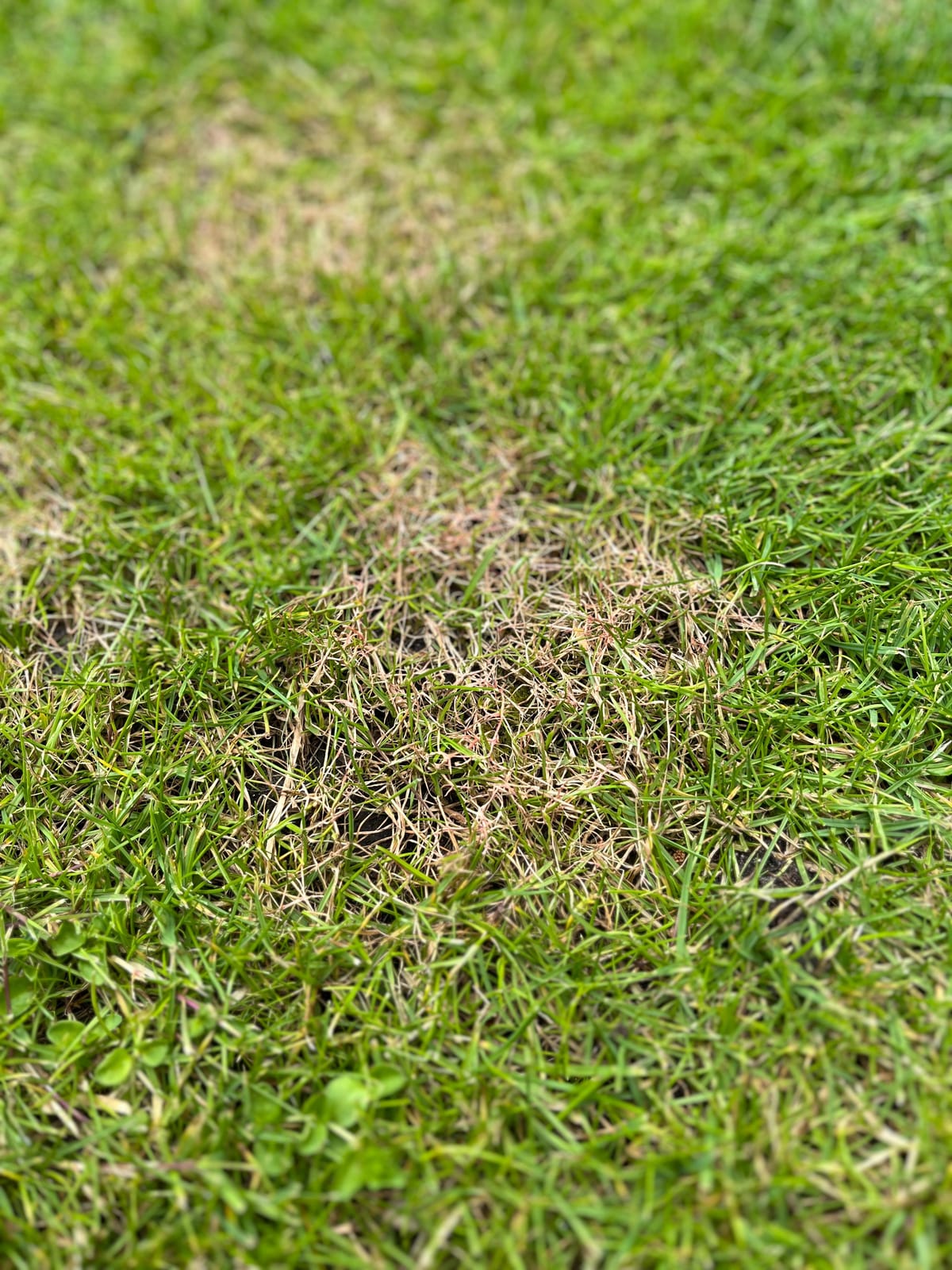
Published: 12th June 2025 Last Updated: 12th June 2025 Reading Time: 10 minutes
Welcome to the second edition of The Lawn Journal - your weekly companion to better lawn care, no matter your experience level.
This week, I cover an in-depth guide to disease identification. Summer can provide ideal conditions for diseases to thrive; it's important to understand what you're dealing with to help your lawn survive.
Share this with fellow lawn lovers who want to stay one step ahead of summer diseases.
This Week: Warm and Wet - The Perfect Storm for Lawn Diseases
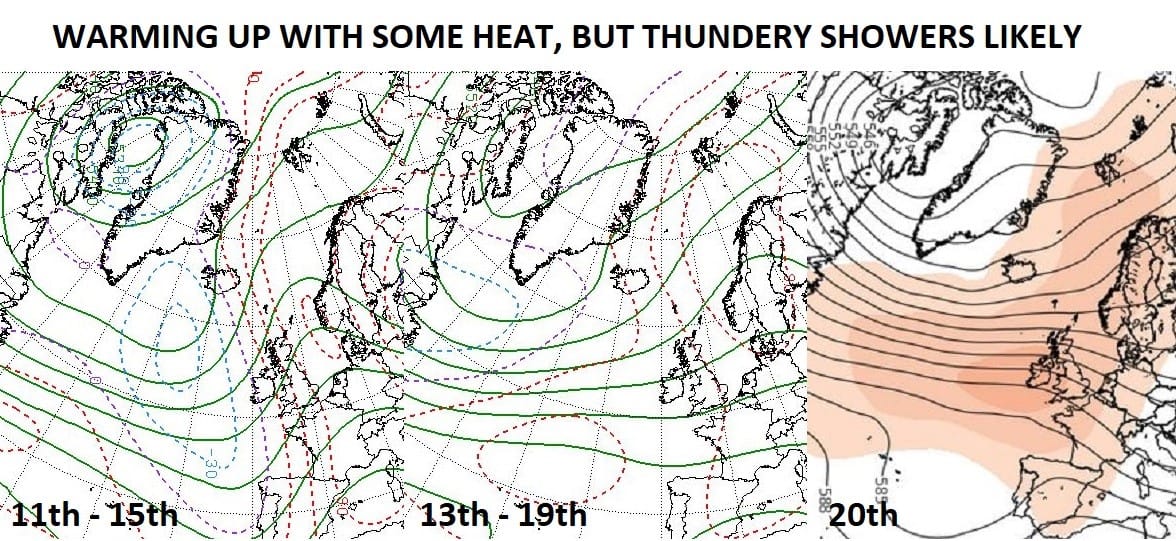
After two weeks of persistent rain across much of the UK followed by a sudden temperature spike, lawns nationwide have been showing signs of recovery since the dry spell through May.
This combination of moisture and warmth creates ideal conditions for fungal diseases to flourish. If you're noticing patches, discolouration, or unusual growth patterns in your lawn, you're not alone—summer lawn diseases are appearing earlier than usual this year.
Looking ahead, forecasts suggest continued warm weather with intermittent showers and thunderstorms over the next 10-14 days. This weather pattern means disease pressure will remain high, making identification and early intervention crucial.
This Week's Action Point:
Take a few minutes to walk your lawn and photograph any suspicious areas. These photos will help with identification and tracking recovery progress.
The Science Behind Summer Lawn Diseases
Understanding the basic science behind lawn diseases helps make sense of what's happening to your grass and why certain treatments are more effective than others.
The Disease Triangle: Why Diseases Appear
Plant pathologists use a concept known as the "disease triangle" to explain why diseases develop. Three factors must be present simultaneously:
- Susceptible Host (your grass)
- Pathogen (disease-causing organism)
- Favourable Environment (weather conditions)
Remove any one of these factors, and the disease cannot develop or spread. Pathogens are naturally present in most soils, so most management techniques focus on either strengthening the host (your lawn) or changing the environment.
Why UK Lawns Are Particularly Vulnerable
Cool-season grasses, primarily perennial ryegrass, fescue, and bentgrass, have evolved for the UK's typically mild, damp climate. However, this adaptation comes with trade-offs:
- Higher susceptibility to certain fungal diseases
- Stress vulnerability during summer temperature spikes
- Dense growth habit that can restrict air movement
- Shallow root systems in many established lawns
Additionally, the UK's climate creates frequent periods of leaf wetness—when grass blades remain damp for extended periods—which is a primary factor in disease development.
The Seasonal Pattern
Summer lawn diseases follow distinct patterns based on temperature and humidity:
- 15-25°C with high humidity: Ideal for red thread and rust diseases
- 20+°C with high humidity and warm night temperatures: Perfect for brown patch
- 20-25°C+ with high humidity: Favours dollar spot, pythium and other aggressive diseases
Understanding these temperature thresholds helps explain why certain diseases appear at specific times and why some years are worse than others for particular problems.
Professional Techniques: Identification and Solutions
Sportsturf management professionals and lawn care experts follow reliable methods for both identifying and addressing common lawn diseases.
Here's how to apply these approaches to your home lawn.
Red Thread Disease
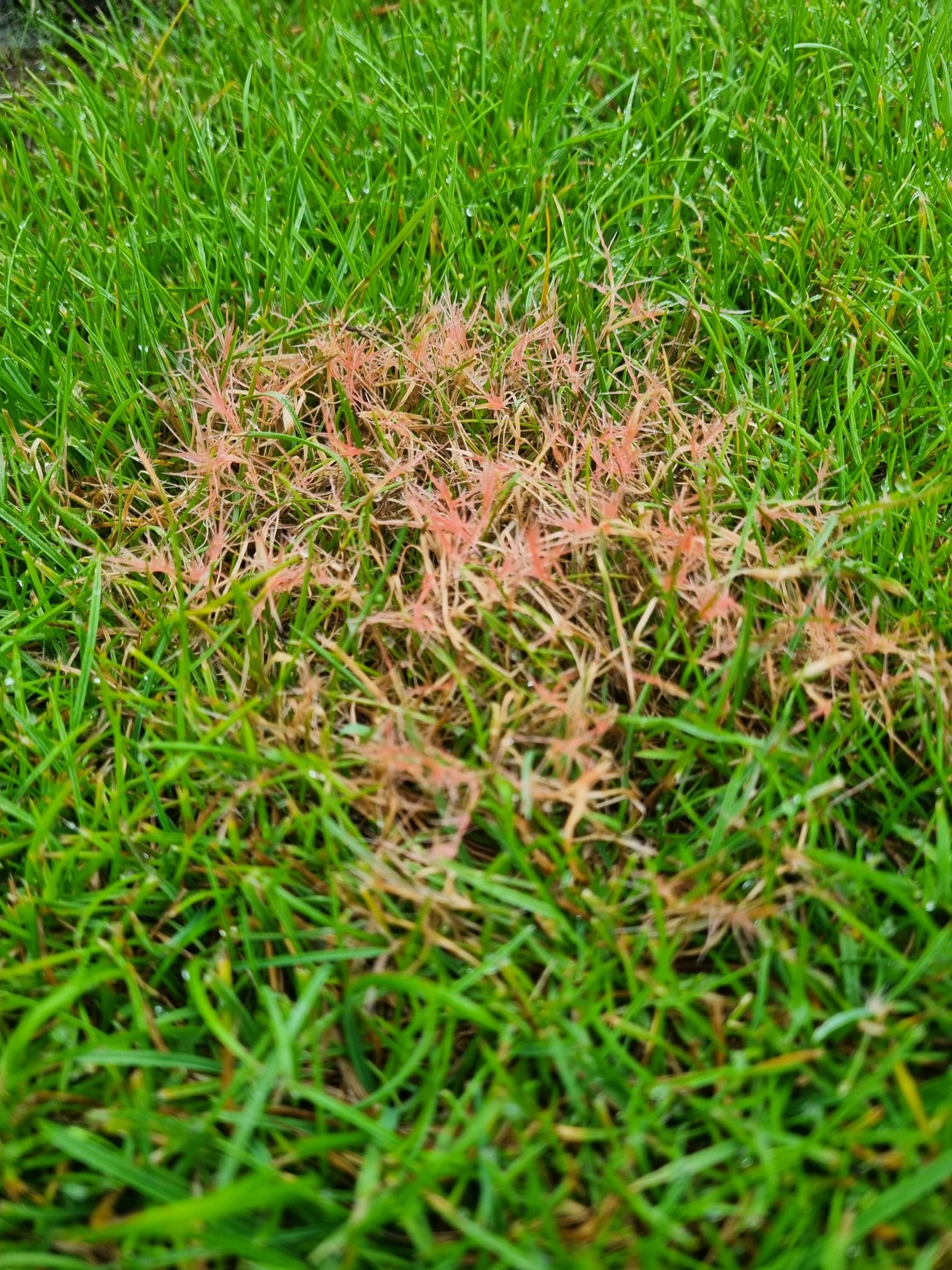
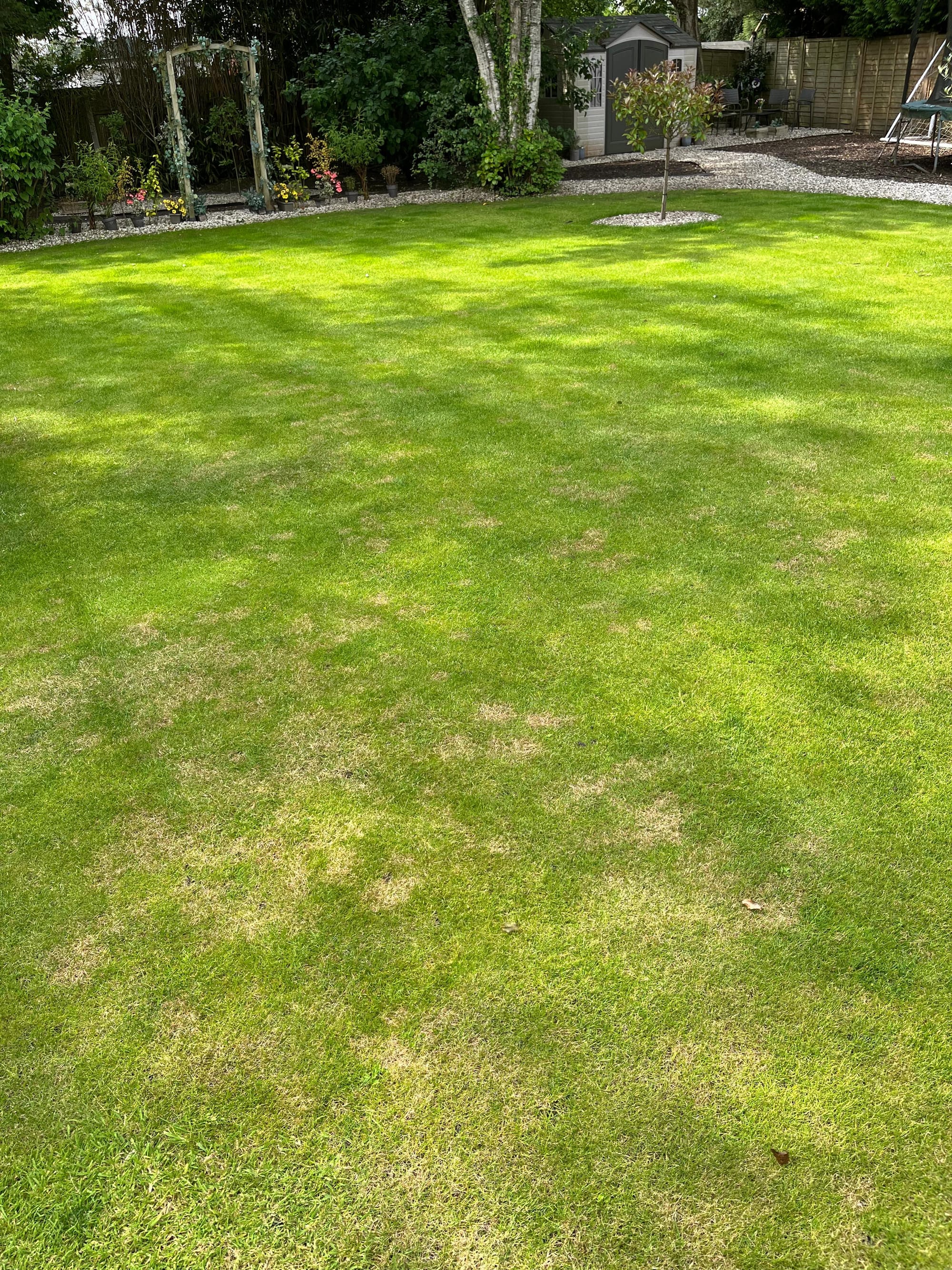

Identification:
- Irregular patches of pinkish or straw-coloured grass, typically 5-30cm in diameter
- Distinctive pink/red threads extending from leaf tips (this is the key identifying feature)
- Most common during humid, wet periods (15-20°C)
- Often appears first in areas with poor drainage or morning shade
Treatment Approach:
- Apply nitrogen fertiliser early at 25-30g/m²
- Improve air circulation by trimming surrounding vegetation
- Raise mowing height to 30-40mm during recovery
- Spike affected areas to improve drainage and air penetration
Dollar Spot
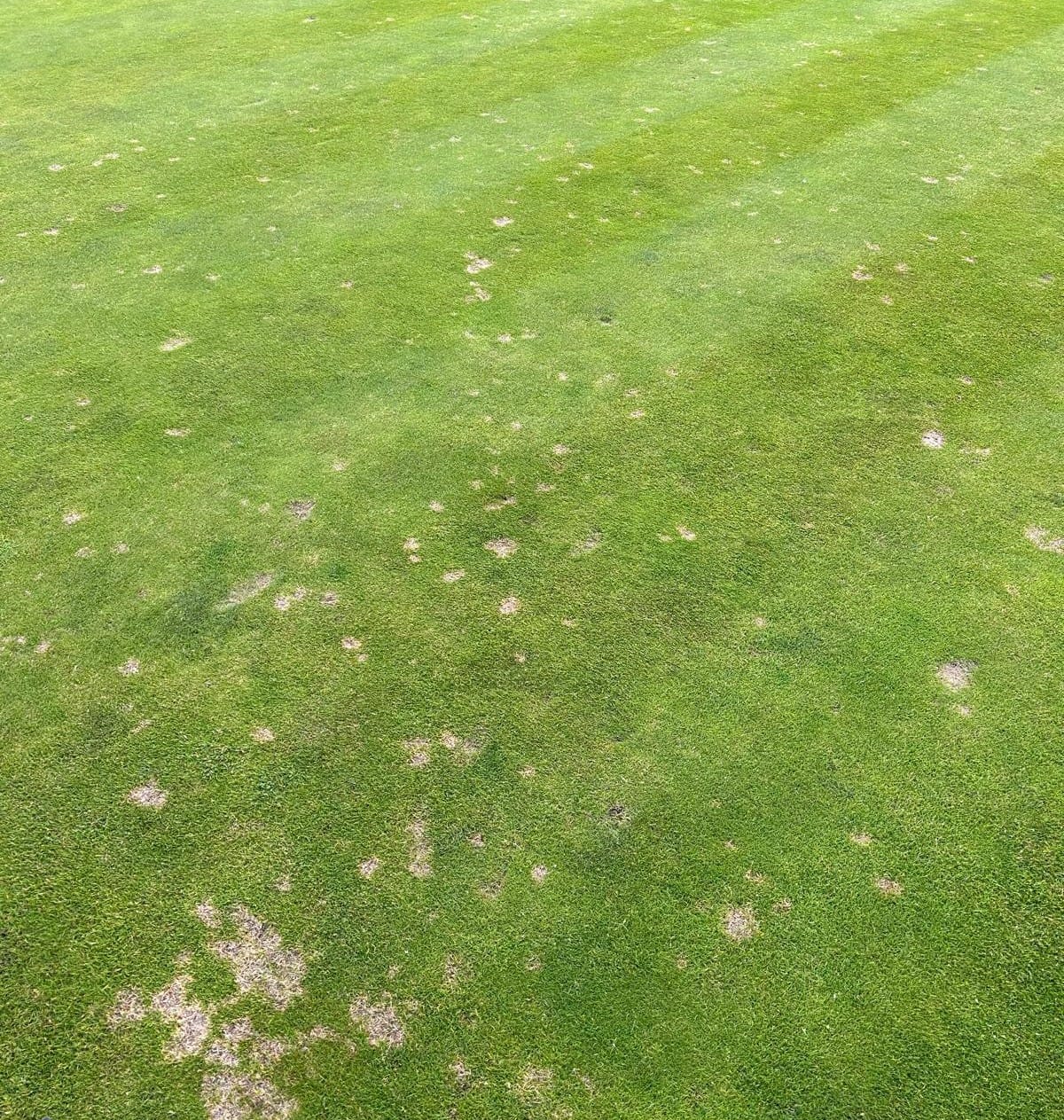
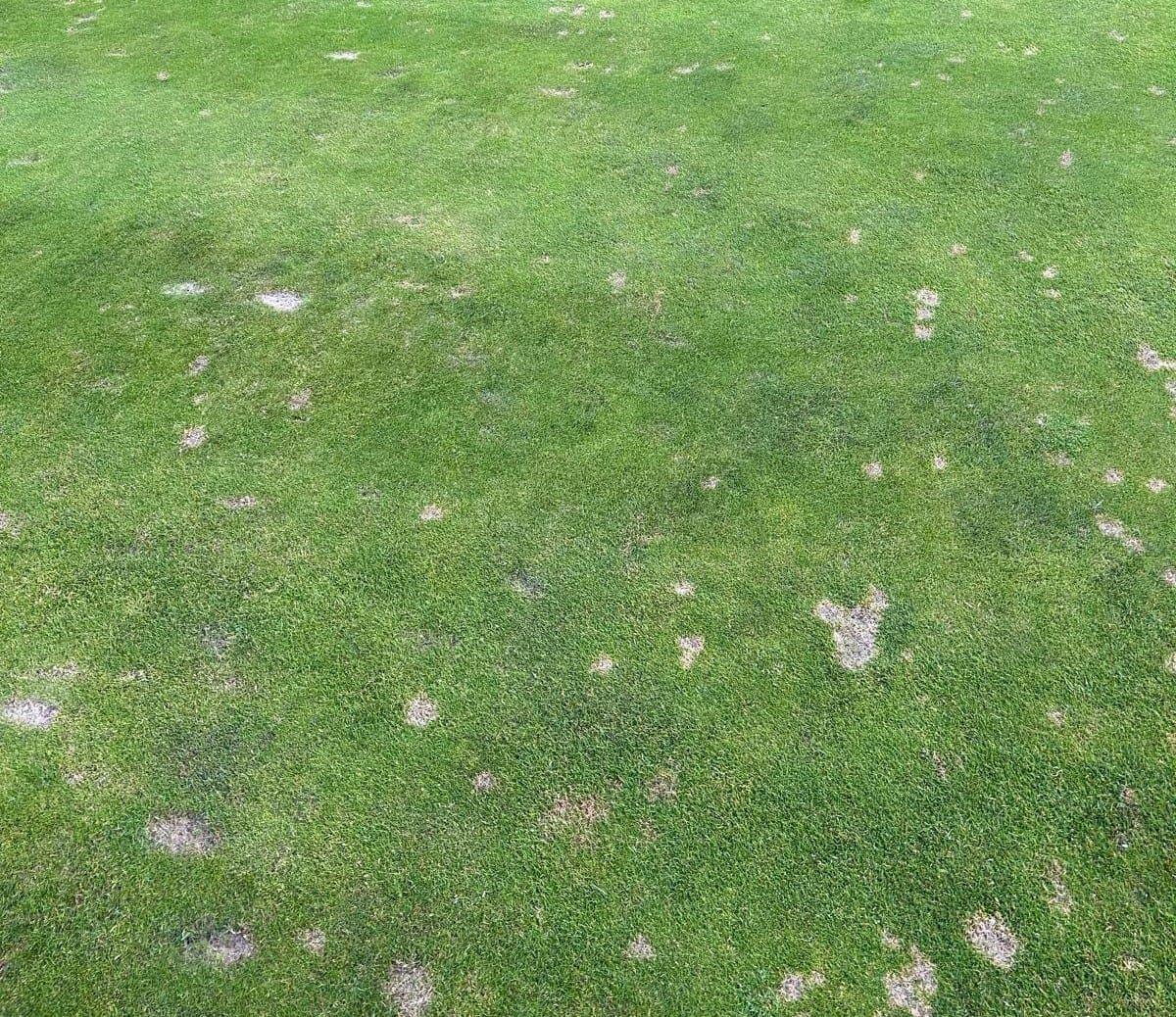
Identification:
- Small, circular patches about the size of a 50p coin (2-5cm)
- Straw-coloured spots that may merge into larger areas
- White, cobweb-like mycelium visible on leaves in early morning dew
- It can spread rapidly, so you will notice changes in your lawn
Treatment Approach:
- Light nitrogen application (15-20g/m²)
- Water deeply but infrequently to avoid prolonged leaf wetness
- Remove dew from grass in the early morning (drag a hose across the lawn)
- Improve air circulation around affected areas
Brown Patch
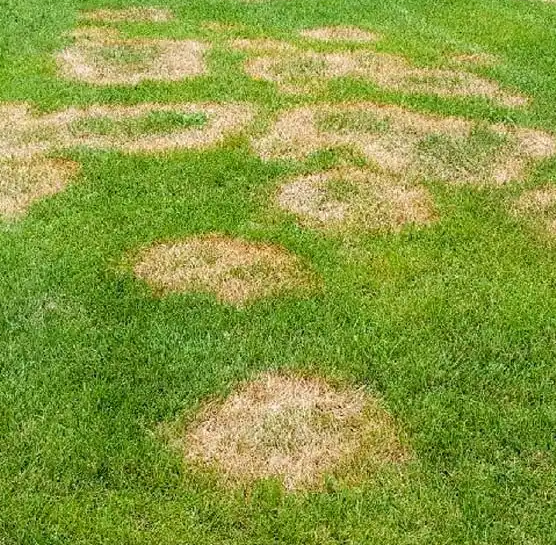
Identification:
- Circular patches of brown grass, 15-30cm in diameter
- Dark "smoke ring" border is visible in early stages
- Appears during warm, humid weather (20-25°C)
- Often worse in over-fertilised or over-watered lawns
Treatment Approach:
- Reduce nitrogen input immediately
- Improve drainage in affected areas
- Water only in the early morning to minimise leaf wetness duration
- Ensure mower blades are sharpened regularly to avoid ripping and stressing the grass leaf.
Rust Disease
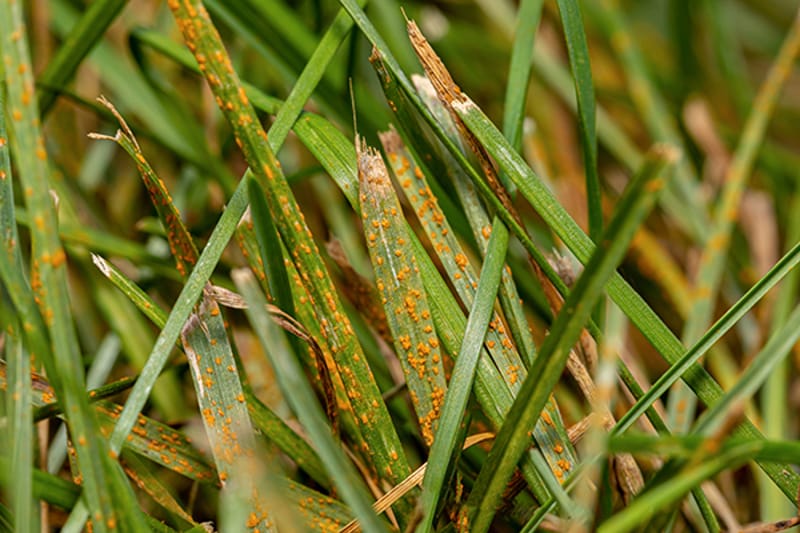
Identification:
- Orange/yellow pustules on grass blades that rub off on shoes or clothing
- Overall yellow or orange appearance when severe
- Most common in late summer during periods of low growth
- Often affects lawns with low fertility or drought stress
Treatment Approach:
- Apply balanced fertiliser to promote growth (20-25g/m²)
- Water deeply once or twice weekly in the absence of rainfall
- Mow regularly to remove infected leaf tips
- Improve air circulation around affected areas
Fusarium Patch (Microdochium Patch)
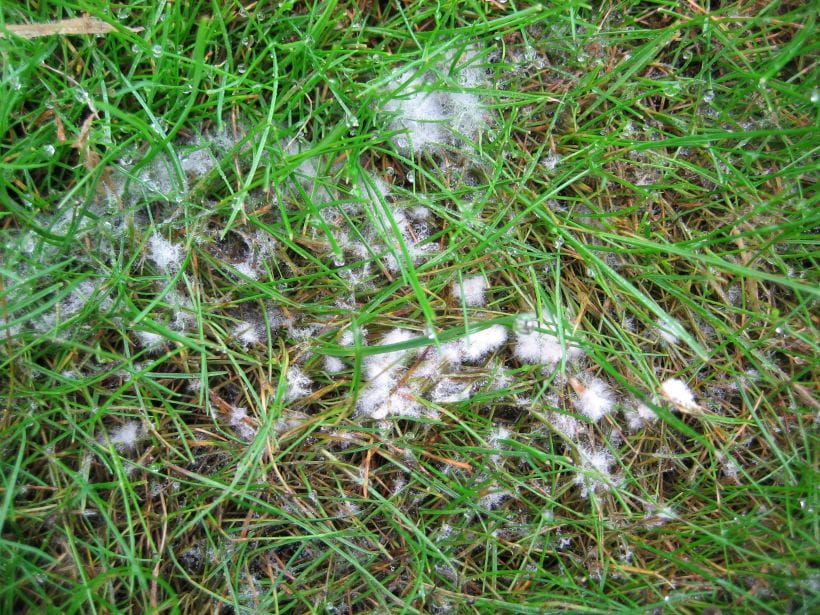

Key identification feature is the white fungus surrounding areas of severely stressed or dead grass patches.
Identification:
- Circular patches of orange/brown grass, 2-15cm in diameter
- White/pink fungal growth is visible in the early morning
- It can appear year-round but often flares in summer after heavy rain
- Common in lawns with excessive thatch
Treatment Approach:
- Reduce irrigation frequency but increase depth when watering
- Improve drainage through spiking or aeration
- Reduce shade where possible to help dry out affected areas
Don't be mistaken:
You may see signs of stress or irregularities within your lawn, but they may not necessarily be a disease.
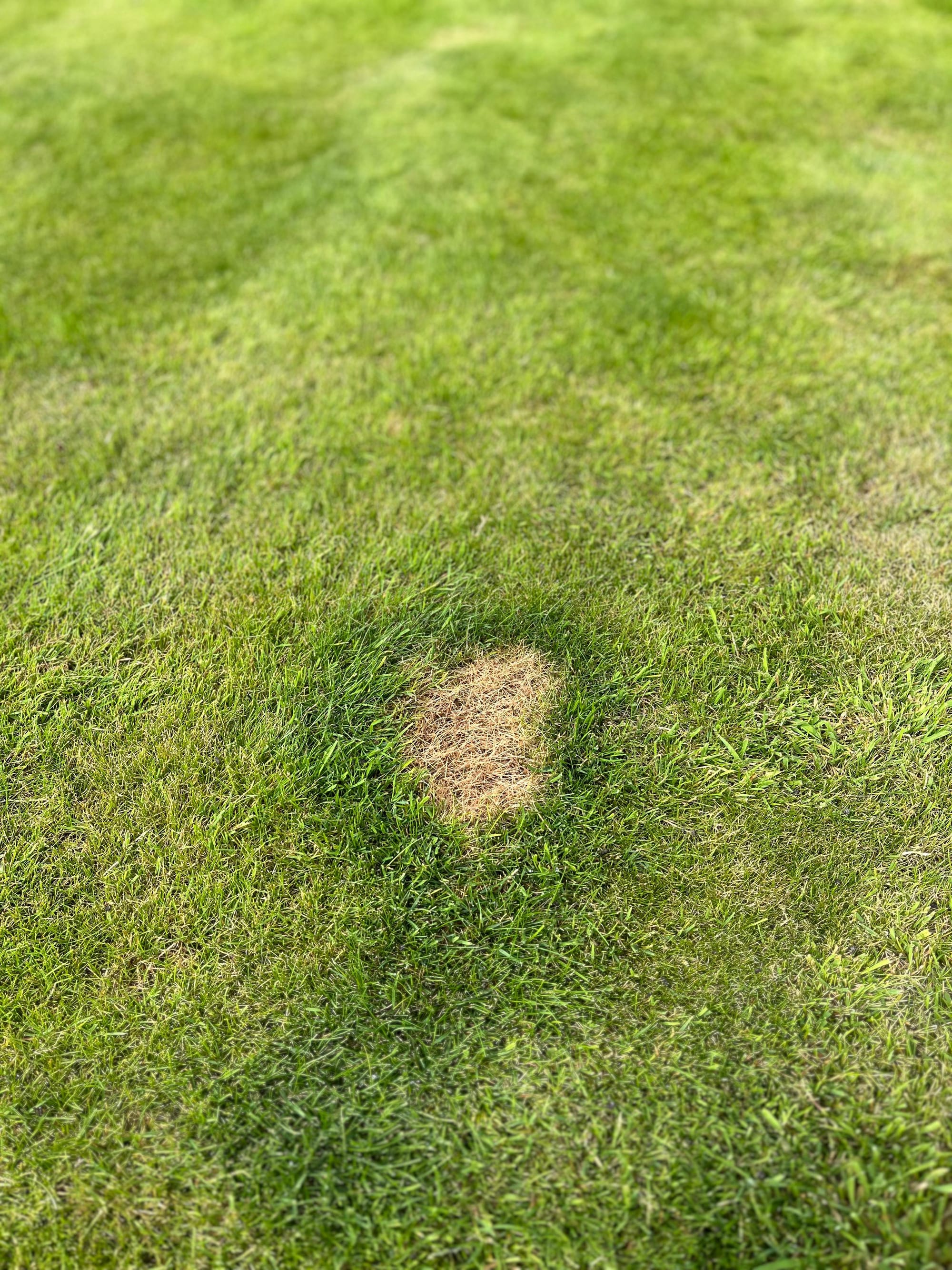
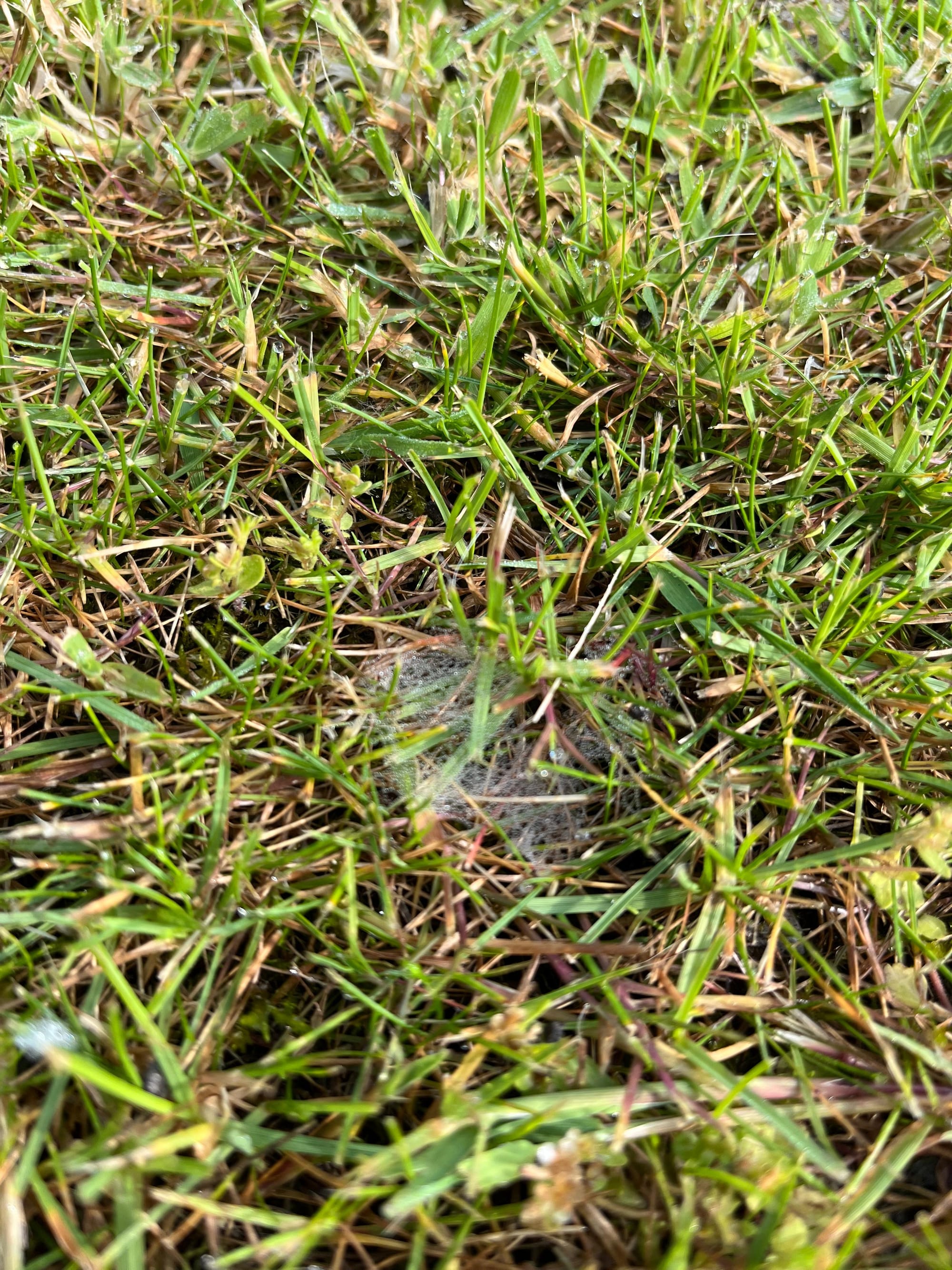
Dog Urine and Spider Webs
Dog urine burn sometimes looks like a brown patch, but you'll notice flourishes of darker, longer grass surrounding it.
Spider webs can sometimes be mistaken for mycelium fungus, but you'll notice the grass will still be healthy, and there will be no active fungus attached to the webs.
The Morning Assessment Walk
Following on from last week's Morning Assessment Walk:
- Go out early, whilst dew is still present on the lawn
- Walk across your lawn in a grid pattern
- Look for areas where the grass appears different in colour or texture
- Pay particular attention to spots that remain damp well into the morning
This simple practice allows you to spot diseases in their earliest stages, when intervention is most effective. The dew makes symptoms more visible, and you'll quickly identify problem areas.
Using professional monitoring systems, such as a disease tracker, will provide you with a platform to learn where problem areas arise and where improvements can be made to reduce the recurrence of disease within your lawn.
Question Time:
Here are answers to the most common questions I receive about summer lawn diseases:
Q: Do I need to apply fungicides to cure lawn diseases?
A: For home lawns, fungicides are rarely necessary. Most summer lawn diseases respond well to cultural practices like proper fertilisation, irrigation management, and mowing adjustments. Professional sports turf sometimes uses fungicides preventatively, or in specific circumstances where playing surfaces need to be at the utmost quality.
Q: Will these diseases kill my lawn completely?
A: Most summer lawn diseases affect the appearance by damaging leaf blades whilst leaving the crown and roots intact. With proper care, your lawn will recover fully. The exceptions are some aggressive diseases like pythium, which can kill grass outright—but these are relatively rare in UK home lawns and typically only appear during extremely hot, humid conditions.
Q: How can I prevent diseases from appearing next year?
A: Lawn diseases aren't fully preventable, but focus on building a resilient lawn through:
- Regular, appropriate fertilisation (3-5 times yearly)
- Proper mowing height (20-40mm for most UK lawns)
- Deep, infrequent watering rather than frequent light watering
- Annual aeration to improve soil structure
- Overseeding with disease-resistant grass varieties in autumn
Q: Can I still use my lawn while it has a disease?
A: Yes, most lawn diseases pose no health risk to humans or pets. However, walking on the lawn during an active outbreak can spread spores and damage recovering grass. Limiting traffic on severely affected areas will help recovery by reducing stress on the grass. For important events, consider temporary traffic restrictions 7-10 days beforehand to allow maximum recovery.
Professional Tips: Techniques from the Field
These are techniques used regularly in managing professional turf that work well for home lawns:
Dew Removal Technique
This simple practice dramatically reduces disease pressure during high-risk periods:
- On dewy mornings, drag a flexible hose or pole across your lawn before the dew dries
- This removes moisture from the grass blades, shortening the leaf wetness period
- Perform this simple task daily during high disease pressure periods
- Best done just as the sun is rising for maximum effect
- Use the same hose to prevent disease spores from spreading
The Stress-Point Management System
- Identify stress points in your lawn:
- Edges where the lawn meets paths or driveways
- Areas under overhanging shrubs or trees
- Spots where water collects after rain
- High-traffic paths or play areas
- Apply preventative care to these areas before problems appear:
- Additional aeration twice yearly
- Supplemental seeding in spring and autumn
- Light applications of seaweed extract monthly during the growing season (more info on seaweed and other micronutrients on an upcoming blog)
- Slightly higher mowing height than the main lawn
This proactive approach to stress points prevents many diseases from gaining a foothold and spreading to the wider lawn.
Feature: Lawn of the Week
To have your lawn featured, send your submissions to:
contact@thelawnjournal.com

Follow @lawn.journal for weekly tips you can actually use 🌱
Here's to a green week ahead!
Ryan,
The Lawn Journal

